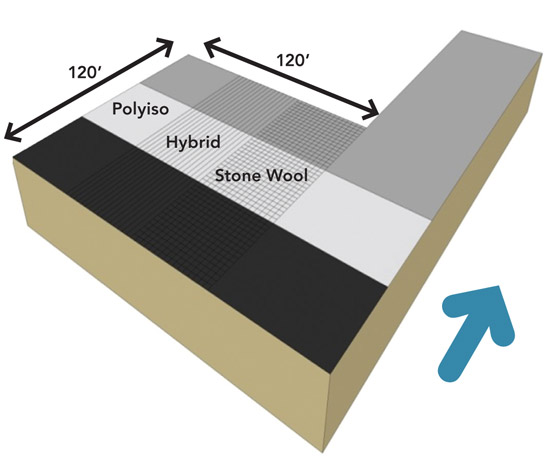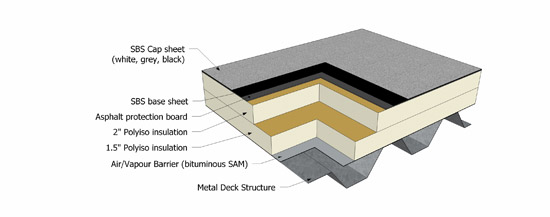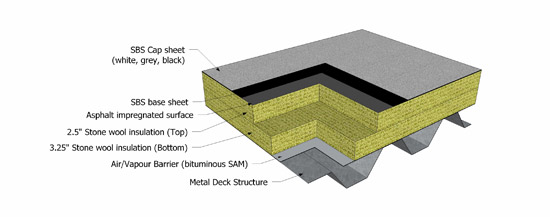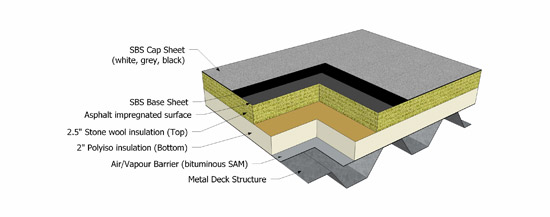Stone Wool Roof Insulation - A Climate Driven Choice
 |
The RDH study looked at different roofing assemblies in place on the same building to compare performance. Source: “Monitored Field Performance of Conventional Roofing Assemblies – Measuring the Benefits of Insulation Strategy” by Marcus Dell, PEng, and Graham Finch, PEng, of RDH Building Engineering Ltd. The paper was presented at the RCI Symposium on Building Envelope Technology, November 2013. |
BSC went on to look at thicker 4-inch layers by stacking 2-inch layers of insulation and using the same test methods as previously. Once again, they found that the performance of the polyisocyanurate insulation declined as the outdoor temperature dropped. This led them to state the following recommendations for using this insulation in cold-temperature climates:
- Use thicker layers of polyisocyanurate insulation to ensure that the performance meets expectations—i.e. the actual R-values will likely be less than the published R-values.
- Use a hybrid insulation approach—install cold temperature-tolerant insulation over the top of polyisocyanurate insulation to increase the mean temperature of the polyisocyanurate.
Field Monitoring Study
In order to determine a more comprehensive understanding of the performance between stone wool and polyisocyanurate insulation used in roofing systems, RDH Building Engineering Ltd. in Vancouver, BC has undertaken a Field Monitoring Study. This ongoing work to be conducted over several years has looked at nine side-by-side roof insulation assemblies with variations in insulation make-up and roofing membrane color. The roofing variables consist of three different two-ply SBS membrane cap sheet colors placed over three different conventional insulation strategies (polyiso, stone wool, and a hybrid combination of both), creating a total of nine unique roofing assemblies (each 16 square, 1,600 ft2 in size) on the same building to study. The thickness of each insulation combination was varied to achieve approximately the same effective R-value in each assembly. Sensors were installed to measure temperature, relative humidity, moisture content, and heat flux at various points within each of the roof assemblies.
Among the findings observed to date:
- Both polyiso and stone wool exhibit a strong temperature-dependent thermal conductivity, though they behave differently at cold and hot temperatures. Since the stone wool does not rely on blowing agents for insulation performance, it demonstrates a more linear relationship between outdoor temperature and thermal performance. Further, the RDH study also observed that the thermal performance of stone wool improves with colder temperatures from standard conditions (75°F), whereas the performance of polyiso declines under both cold and hot conditions.
- A roof constructed with 3.5 inches of polyiso may have a code-acceptable calculated R-value of R-21.3, but when exposed to cold (14°F) would drop to R-20 or as low as R-16.5 depending on its age; and when exposed to hot (167°F membrane surface) temperatures would drop to R-16.5 or as low as R-14 depending on its age.
- In the hybrid assembly (4.5 inches thick), the use of a layer of stone wool insulation (in this case, equivalent to approximately 45 percent of the assembly R-value) over the top of the polyiso significantly improves the effective R-value of the polyiso as it keeps it near optimum temperatures (which are similar to typical interior temperatures); and therefore, results in a better assembly R-value in cold and hot conditions.
- The roof assembly insulated with entirely stone wool insulation (at 5.75 inches thick) will have a more stable R-value (increasing at colder temperatures and slightly decreasing at hot temperatures from calculated R-value), and is not susceptible to a loss of R-value with age.
 |
Polyiso Roof Assembly Image courtesy of RDH Building Engineering Ltd. |
 |
Stone Wool Roof Assembly Image courtesy of RDH Building Engineering Ltd. |
Based on the above, important considerations when designing roof assemblies include:
- Stone wool and hybrid roofs will maintain R-values close to calculated values, whereas the R-value in the roof with polyiso will drop a significant amount when exposed to cold or hot outdoor (and solar radiation induced) temperatures.
- The higher heat capacity of stone wool insulation reduces the peak membrane temperature, which is positive for the longevity of the membrane and reduces the peak interior temperature, which is a positive for the occupants.
- Stone wool has a more stable R-value than polyiso so it insulates better when exposed to larger temperature differences.
 |
Hybrid Stone Wool & Polyiso Roof Assembly Image courtesy of RDH Building Engineering Ltd. |
The overall conclusion that can be drawn from all of this collective work is that climate and location matter when selecting roofing insulation. The use of insulation that does not perform as expected will likely increase the actual energy consumption within buildings in both cold and hot climates. This is an important consideration to overall performance and will be a factor when sizing mechanical equipment as well. Climate driven R-values, based on the mean temperature between indoor and outdoor conditions, need to be accounted for in design.









